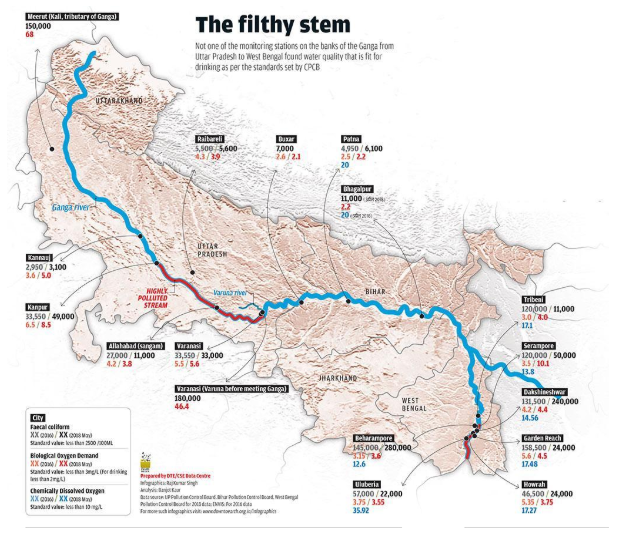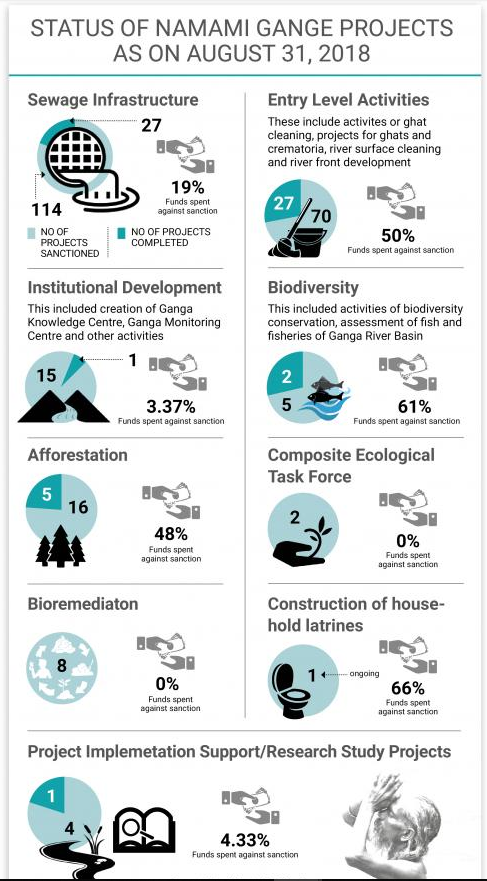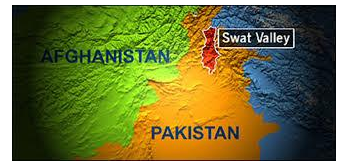IASbaba's Press Information Bureau
Press Information Bureau (PIB) IAS UPSC – 13th May to 18th May – 2019
GS-3
Namami Gange Mission
(Topic: Conservation, environmental pollution and degradation, environmental impact assessment)
Aims at providing comprehensive and sustainable solutions for a cleaner ecosystem along the stretch of 97 towns and 4,465 villages on the Ganga stem
- Namami Gange is being implemented by the National Mission for Clean Ganga (NMCG), and its state counterparts—State Programme Management Groups.
- According to a map of Ganga river water quality presented by the Central Pollution Control Board (CPCB) to National Green Tribunal (NGT) in August 2018, only five out of 70-odd monitoring stations had water that was fit for drinking and seven for bathing
Only 10 of 100 Ganga sewage projects completed
- The NDA government has only finished 10 of the 100 sewage infrastructure projects commissioned after 2015 under the Namami Gange mission, according to records.
- Nearly ₹23,000 crore has been sanctioned of the ₹28,000 crore outlay for sewage management work.
- Commissioning of sewage treatment plants (STP) and laying sewer lines are at the heart of the mission to clean the Ganga. However, river-front development, cleaning ghats and removing trash from the river, which are just the cosmetic side of the mission make up about for ₹1,200 crore of the mission outlay.
Do you know?
- The bulk of the projects completed were those commissioned before the Ganga mission began work in earnest under programmes such as the Ganga Action Plan-1 and Ganga Action Plan-2, which began in 1987 and 1996 respectively.
- Ganga Gram Project
- The Ministry of Drinking Water and Sanitation (MDWS) launched ‘Ganga Gram’ – a project for sanitation based integrated development of all 4470 villages along the River Ganga.
- Ganga Gram vision is an integrated approach for holistic development of villages situated on the banks of River Ganga with active participation of the villagers.
- After achieving ODF target in Ganga Villages, implementation of solid and liquid waste management and other integrated activities are remaining tasks.
- Ministry of Drinking Water and Sanitation is the nodal agency for implementation of the Ganga Gram Project.


Must Read: Link 1
Connect the Dots:
- How far has the Namami Gange initiative succeeded in addressing the water quality of the Ganges? Critically examine.
- There are evidences that bacterial contamination along Varanasi’s ghats has actually increased increased in the past few years. What can be the possible reasons behind this? Why hasn’t the Namami Gange project taken up? Examine.
India sets the tone at COP meetings of Basel, Rotterdam and Stockholm conventions
(Topic:
- Conservation, environmental pollution and degradation, environmental impact assessment
- Impact of Climate Change and Global Warming)
The joint meetings of three conventions on chemicals and waste that is the fourteenth meeting of the Conference of the Parties (COP) to Basel Convention on the Control of Transboundary Movement of Hazardous Wastes and their Disposal (COP 14) was held along with the ninth meeting of the COP to Rotterdam Convention on the Prior Informed Consent Procedure for Certain Hazardous Chemicals and Pesticides in International Trade and the ninth meeting of the COP to Stockholm Convention on Persistent Organic Pollutants.
The theme of the meetings this year was “Clean Planet, Healthy People: Sound Management of Chemicals and Waste”.
In Basel Convention, two important issues were discussed and decided, i.e
- Technical guidelines on e-waste
- Inclusion of plastic waste in the PIC procedure
E-waste
The draft technical guidelines stipulated the conditions when used electrical and electronic equipment destined for direct reuse, repair, refurbishment or failure analysis should be considered as non-waste. India had major reservations regarding these provisions as in the name of re-use, repair, refurbishment and failure analysis there was a possibility of dumping from the developed world to the developing countries including India in view of the growing consumption of electronic equipment and waste across the world. The Indian delegation strongly objected the proposed decision on these guidelines during plenary and did not allow it to be passed by the conference of the parties (COP). The issues then resolved were:
- Dumping of e-waste in developing countries
- Recognition that the interim guideline has issues and further work is required specially on the provision on distinguishing waste from non-waste
- The guidelines were adopted on an interim basis only
- The tenure of the expert working group was extended to address the concerns raised by India
- The usage of interim guidelines to be done only on a pilot basis
Inclusion of plastic waste in the PIC procedure
- Under the Basel Convention, another major achievement of COP 14 was the decision to amend the convention to include unsorted, mixed and contaminated plastic waste under PIC (Prior Informed Consent) procedure and improve the regulation of its transboundary movement. This is a significant step taken towards addressing plastic pollution which has become a major environmental concern across the globe.
- Further, Basel Convention has also adopted partnership on plastic which was welcomed by the Indian delegation. These steps will help prevent the illegal dumping of plastic wastes in developing countries.
- India has already imposed a complete prohibition of import of solid plastic waste into the country.
- India has also made an international commitment to phase-out single-use plastic. India fully supported this exercise and one of the members of the Indian delegation was co-chair in the contact group which negotiated this agreement for amendment in the annexes of Basel Convention to bring plastic waste under PIC procedure.
Under the Stockholm Convention the COP decided to list “Dicofol” in Annex A without any exemption. The “PFOA” was also listed with some exemptions in the Annex A of the Stockholm Convention. Under the Rotterdam Convention, two new chemicals (Phorate and HBCD) were added in the list for mandatory PIC procedure in international trade.
Prelims oriented news:
Eve of Buddha Purnima
Celebration of birth of the Prince Siddhartha Gautama, later the Gautama Buddha and founder of Buddhism
- According to the Theravada Tripitaka scriptures (from Pali, meaning “three baskets“), Gautama was born c. 563/480 BCE in Lumbini in modern-day Nepal, and raised in the Shakya capital of Kapilvastu, in the present day Tilaurakot, Nepal.
- At the age of thirty five, he attained enlightenment (nirvana) underneath a Bodhi tree at Bodhgaya (modern day India).
- He delivered his first sermon at Sarnath, India.
- At the age of eighty, he died at Kushinagar, India.
Restoration of Ancient rock carving of Buddha: Swat Valley, Pakistan
It was blown up by the Taliban as militants overran Pakistan’s Swat valley a decade ago.
Key pointers:
- 7th-century Buddha of Swat valley, Pakistan
- Seated serenely in the lotus position (meditative posture)
- considered one of the largest rock sculptures in South Asia
- foothills of the Himalayas
- Italian government helped to preserve the cultural heritage and restore the six-metre-tall Buddha of Swat
- Swat, a picturesque valley in the Khyber Pakhtunkhwa Province of Pakistan

Rare stucco statue put on show in Hyderabad
In news:
- Nearly 1,700 years after a life-size stucco Bodhisattva was created by craftsmen at Phanigiri during the peak of the Ikshvaku dynasty rule, the 1.74-metre statue was put on display.
- Brown and white fragments of the statue covered with soil were laid out on two tables at the State Museum at Gunfoundry.
- This is a stucco statue and lot of soil and earth has accreted to the figure. Officials said it was one of the rare life-size figures in stucco to be unearthed in India.
- The unearthing of a large number of artefacts and structures at Telangana’s Phanigiri site has thrown light on the Buddhist civilization that thrived there.
About Bodhisattva
- In early Buddhism, bodhisattva meant “the previous lives of a (or the) Buddha.”
- In Mahayana Buddhism, bodhisattva refers to a human being committed to the attainment of enlightenment for the sake of others. Becoming a bodhisattva is the goal of Mahayana Buddhism.
- Bodhisattva may also refer in Mahayana Buddhism to archetypal bodhisattvas: mythical beings such as Avalokiteshvara and Manjushri, who are objects of devotion. to protect wildlife as summer peaks
Second century BCE Buddhist site at Thotlakonda in Visakhapatnam
In news:
- Heritage conservationists and members of Indian National Trust for Art and Cultural Heritage (INTACH) has expressed concerns over proposed construction of amphitheatre, rest rooms and information centre at second century BCE Buddhist site, Thotlakonda in Visakhapatnam.
- Buildings might mar the original heritage site and are against the norms laid down by the courts.
- Court had ordered – no construction or development activity of any sort shall be permitted within the boundaries of the ancient site
- Tourism should be developed but not at the cost of protected areas
- Thotlakonda site was first discovered in 1976
- The excavations conducted by ASI revealed the ruins of a well-established Theravada (Hinayana Buddhism) monastery
Note:
- Under Article 49 of the Constitution, the State is under obligation to protect every monument, place or object of artistic or historic interest declared to be of national importance from spoilation, disfigurement, destruction, removal, disposal or export, as the case may be. (DPSP)
- Under Article 51A(f) of the Constitution, there is fundamental duty to value and preserve the rich heritage of our composite culture. (Fundamental Duties)
Revision Questions
1. With reference to the history of ancient India, which of the following was/were common to both Buddhism and Jainism? (2012)
- Avoidance of extremities of penance and enjoyment
- Indifference to the authority of the Vedas
- Denial of efficacy of rituals
Select the correct answer using the codes given below:
(a) 1 only
(b) 2 and 3 only
(c) 1 and 3 only
(d) 1, 2 and 3
Solution (b)
2. Lord Buddha’s image is sometimes shown with the hand gesture called ‘Bhumisparsha Mudra’. It symbolizes (2012)
(a) Buddha’s calling of the Earth to watch over Mara and to prevent Mara from disturbing his meditation
(b) Buddha’s calling of the Earth to witness his purity and chastity despite the temptations of Mara
(c) Buddha’s reminder to his followers that they all arise from the Earth and finally dissolve into the Earth, and thus this life is transitory
(d) Both the statements (a) and (b) are correct in this context
Solution (b)
3. Which of the following Kingdoms were associated with the life of the Buddha? (2014)
- Avanti
- Gandhara
- Kosala
- Magadha
Select the correct answer using the code given below.
- 1, 2 and 3
- 2 and 4
- 3 and 4 only
- 1, 3 and 4
Solution (d)
4. Some Buddhist rock-cut caves are called Chaityas, while the others are called Viharas. What is the difference between the two?
(a) Vihara is a place of worship, while Chaitya is the dwelling place of the monks
(b)Chaitya is a place of worship, while Vihara is the dwelling place of the monks
(c) Chaitya is the stupa at the far end of the cave, while Vihara is the hall axial to it
(d) There is no material difference between the two
Solution (b)
5. With reference to the religious history of India, consider the following statements: (UPSC 2016)
- The concept of Bodhisattva is central to Hinayana sect of Buddhism.
- Bodhisattva is a compassionate one on his way to enlightenment.
- Bodhisattva delays achieving his own salvation to help all sentient beings on their path to it.
Which of the statements given above is/are correct?
- 1 only
- 2 and 3 only
- 2 only
- 1, 2 and 3
Solution (b)
Connect the Dots:
- Critically analyze the contributions of Buddha to the religion and philosophy of India. What were his main principles and how did he manage to have such a large following?
- “Buddhism was not just a religious revolution, but a social revolution too.” Comment.
- The theme of Lord Buddha in meditation finds a prominent place in the rich visual art forms of India. Discuss.
Sasakawa Award 2019: United Nations Office for Disaster Risk Reduction (UNDRR) conferred Sasakawa Award 2019 for Disaster Risk Reduction to Dr. Pramod Kumar Mishra, Additional Principal Secretary to Prime Minister of India. The award was announced during the ongoing 6th Session of Global Platform for Disaster Risk Reduction (GPDRR) 2019 at Geneva.
Flight Test of ABHYAS
- Defence Research and Development Organisation (DRDO) conducted successful flight test of ABHYAS – High-speed Expendable Aerial Target (HEAT) from Interim Test Range, Chandipur in Odisha
- Designed on an in-line small gas turbine engine and uses indigenously developed MEMS based navigation system for its navigation and guidance.











